![]()
![]()
![]()
Use LEFT and RIGHT arrow keys to navigate between flashcards;
Use UP and DOWN arrow keys to flip the card;
H to show hint;
A reads text to speech;
53 Cards in this Set
- Front
- Back
|
Describe Tissues |
= collections of specialized cells isolated from other tissues by membranous layers Animal body plans also vary according to the organization of the animal’s tissues Sponges have no true tissues, but all other animals do |
|
|
Ecoderm vs. Endoderm Animalembryos have concentric cell layers called ____________ that form tissues and organs |
Animal embryos have concentric cell layers called germ layers that form tissues and organs Ectoderm is the germ layer covering theembryo’s surface --> Givesrise to skin and nervous system Endoderm is the innermost germ layer –- >Gutlining and organs derived from it, incl. lungs, liver |
|
|
Diploblastic vs. Triploblastic |
Diploblastic animals have just ectoderm andendoderm --- > Jellyfish,corals, sea anemonies --> Alsohave radial symmetry Triploblastic animals also have an intervening mesoderm layer --> Givesrise to muscles and other organs between digestive tract and skin -->Inall bilaterally symmetrical animals |
|
|
Describe Body cavities in triploblastic animals A true body cavity is called a _______ and is derived from _____________ |
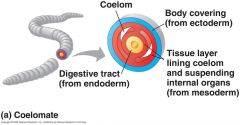
–Allowsinternal organs (e.g. heart, lungs, digestive tract, etc. ) some freedom ofmovement –Fluidw/icavity protects & cushions organs –Mayact as hydrostatic skeleton A true body cavity is called a coelom and is derived from mesoderm |
|
|
A _____________ is a body cavity derived from the _________ , rather than from __________ |
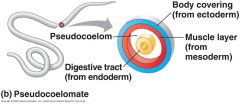
A pseudocoelom is a body cavity derived from the blastocoel, rather than from mesoderm |
|
|
______________ are animals without ____________ |
Acoelomates are animals without body cavities |
|
|
Triploblastic animals can bedivided into two groups based on how the body cavity forms and a few otherfeatures of embryonic development…what are the two groups |
Twotypes of development in triploblastic animals:Protostomes vs. Deuterostomes |
|
|
Describe Protostomes |
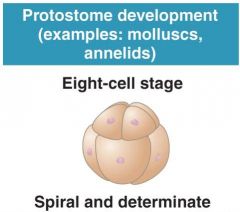
In protostome development, cleavageis •spiral - cells vertically staggered •determinate –No“stem cells”; cell differentiation is programmed after the first cell division |
|
|
Describe Deuterostomes |
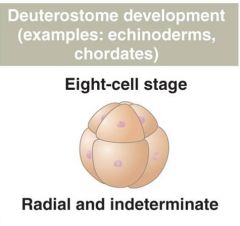
In deuterostome development, cleavage is •radial - cells vertically aligned •indeterminate –Individual cells (=embryonic stem cells) isolated at 4- or 8-cell stage can still divide to form a new viable embryo (totipotent) |
|
|
Coelom Formation |
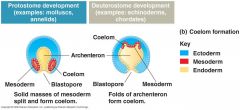
•Inprotostomes: schizocoelous development –solid masses of mesoderm split --> coelomiccavity •Indeuterostomes: enterocoelous development –coelom initially connected to archenteron |
|
|
Fate of the Blastopore |
•In protostome development, theblastopore becomes the mouth •In deuterostome development, theblastopore becomes the anus |
|
|
Newviews of animal phylogeny are emerging from molecular data |
•Zoologists recognize about threedozen animal phyla •Current debate in animalsystematics has led to the development of several phylogenetic hypotheses |
|
|
One proposed phylogeny based on molecular data: |
Most proposals are in agreementthat 1.allanimals share a common ancestor (monophyletic) 2.sponges(“Porifera”) are basal animals (may beparaphyletic) 3.eumetazoans (true tissues) are a monophyleticgroup 4.mostanimals belong to clade “bilateria” (also triploblastic; originatedduring Cambrian explosion) 5.chordates(incl. vertebrates) and echinoderms are deuterostomes |
|
|
Human belong to the class __________ |
Humansbelong toThe Class Mammalia •Phylum: Chordata (dorsal hollow nerve cord) –Subphylum: Vertebrata (vertebrates) •Characteristicsof mammals: 1.Mammary glands - mothers producemilk for their young 2.Hair - heat retention; camouflage;protection 3.Differentiated teeth - incisors,canines, premolars, molars •15living orders |
|
|
HUmans belong to which group and order |
•The mammalian order Primates includes lemurs, tarsiers, monkeys, andapes •Humans are members of the ape group |
|
|
Characteristics of Primates |
•Primarily tree-dwelling (arboreal) •Most primates have hands and feet adaptedfor grasping -Flatfingernails-Skinridges on fingers •Other characteristics of primates: –Forward-looking eyes close togetheron the face, providing depth perception –A fully opposable thumb –A large brain with a well-developedcerebral cortex –Short jaws |
|
|
What are the three main groups of living primates |
–Lemurs (incl. lorises & pottos) –Tarsiers –Anthropoids (= monkeys and apes) •Lemurs (Madagascar) resemble ancestralprimates •Tarsiers (S. Pacific Islands) closer toAnthropoids |
|
|
Old vs. new monkeys |
•Thefossil record indicates that New and Old World monkeys split into separategroups about 35 million years ago •NewWorld and Old World monkeys evolved along different pathways during their manymillions of years of separation |
|
|
History of Hominoids |
•Theother group of anthropoids, the hominoids, consists of primates informally calledapes •Hominoidsdiverged from Old World monkeys about 20–25 million years ago |
|
|
Gibbons |
Brachiation: use of arms to swing from tree to treeainer |
|
|
Gorillas |
•Polygynous mating system •Males2X as large as females -Intrasexual selection (male-male competition) --> sexual dimorphism |
|
|
Describe hominoids |
•All hominoids have –Short tails –Large brain relative to body size –Complex social behaviour |
|
|
Human are _______ ___________ with a large ________ |
Humansare bipedal hominoids with a large brain Human have only existed for 200,000 yrs compared to earth's 3.5byo |
|
|
Characteristics of Humans |
•A number of traits distinguish humansfrom other hominoids: –Upright posture and bipedallocomotion –Shortened jaw with reduced teethand jaw muscles –Shorter digestive tract –Larger brains : •Sophisticated language capabilities•Symbolic thought•The manufacture and use of complextools |
|
|
The earliest Humans |
•The study of human origins is knownas paleoanthropology •Paleoanthropologists havediscovered fossils of about 25 species of extinct hominoids more closelyrelated to humans than to chimpanzees •These species are known as hominins (= Tribe Homininae) •Originatedin Africa ~7 million years ago |
|
|
What Darwin trying to discover in the 19th century? |
•Search began for “missing link”between humans and apes. •Assumed large brains evolved first,then upright posture Missinglink should be a large-brained quadrupedal ape |
|
|
Which came first bipedal or big brains? |
Bipedal motion, first thing to elove and large brain came later •Manyfossils found in 20th century ØInitially, hominins had small brains but probablywalked upright •Alsohad small bodies (~40 kg) and large teeth with a projecting lower jaw |
|
|
What is the Sahelanthropus tchadensis? |
•6-7mya // Oldest known hominin •Foramenmagnum: hole in skull where spinal cord attaches to brain –In chimps: at back of skull –In S. tchadensis: on bottom of skull --> more uprightposture •Brainwas 400-500 cm3 (proportionately similar to that of achimp) ØBipedalismwas one of earliest hominintraits; evolved before large brain |
|
|
Who is Australopiths? |
•A group of hominins (Genus Australopithecus) living between 4 and 2 million yearsago •Some species walked fully erect and hadhuman-like hands and teeth |
|
|
Describe Australopithecusafarensis? |
•Bipedal •Long arms --> capable of brachiation •Brain similar in size to that of Sahelanthropus •Didnot make tools–Butlikely used sticks, stones w/o modification •Males ~1.5x as large as females |
|
|
Bipedalism, why did it evolve? |
1. Main theory: Climate change - 10m.y.a.: India collided with Eurasia --> created Himalayan mountains –Alteredweather patterns in Northern Africa --> drier climate –Treesdisappeared, replaced by grasslands –Uprightposture evolved as a more efficient way of traveling long distances over flatground (uses less energy than scrambling on all fours) 2. Bipedalism may have begun to evolve in an arboreal setting –“Hand-assistedbipedalism” - i.e. using branches like railings – might have enabled early hominins to walk on branches too small tocrawl on using all fours |
|
|
GenusHomo ... Homohabilis |
•Homo habilisis the oldest described species, 2.4 - 1.6 mya (but fossils of Homoup to 2.8 myorecently found) •Shorter jaw & larger brain (~600-750cm3) •Used sharp stone tools–Sharp chips broken off larger rocks •Ate more meat than Australopithecus |
|
|
Homoergaster |
•Homo ergasterwas the first large-brained hominin (~900 cm3) •The species existed between 1.9 and 1.6million years ago •Males only ~1.2x as large as females - Lessmale-male competition; more pair bonding - H.ergaster used more sophisticated stonetools than H.habilis (flint handaxes) |
|
|
Homoerectus |
•Originated in Africa about 1.9 millionyears ago •Brain ~ 1200 cc •First hominin to –use fire–leave Africa •1.8 million-year-old fossils foundin Soviet Republic of Georgia •Established populations in Europeand Asia |
|
|
Homo heidelbergensis |
•0.8 - 0.1 mya •Brain up to 1400 cc •Spread from Africa into Europe and Asia •Direct ancestor of both humans and neanderthals |
|
|
Neanderthals |
•Homo neanderthalensis appeared in Europe and the Near East ~300,000 years ago –Didnot originate in Africa (?) •Physically more robust than modern humans •Brains were as large as, or larger than,those of modern humans (1900 cc?) •Became extinct 28,000 years ago - a fewthousand years after the arrival of Homosapiens in Europe •DNAextracted from fossils indicates Neanderthals are notthe ancestors of modern humans. Theyrepresent a separate (now extinct) branch of hominin evolution. •Genome99.5% similar to humans (c.f. chimp: 98.7%) |
|
|
Whydid Neanderthals go extinct? First hypothesis |
Hypothesis1: they interbred (“blended”) withhumans •Evidence: fossil DNA indicates some, butnot much, interbreeding with H.sapiens –Unlikelyto have been assimilated |
|
|
Why did Neanderthals go extinct? 2nd and 3rd hypothesis |
Hypothesis2: Competition with Homo sapiens invading Europe Hypothesis3: Climate change •Expansion of European glaciers during thelast ice age (Max. glaciation occurred ~20,000 years ago) ØFor whatever reason, H. sapiens was the only homininleft after the ice age ended (~10,000 years ago) |
|
|
Homosapiens |
•Homo sapiens appeared in Africa at least 195,000years ago •All modern humans are descended from anAfrican population •The oldest fossils of Homo sapiens outside Africa date back about 50,000years ago •First appearance in New World: 15,000 ya |
|
|
Human Speech |
•Compared with Neanderthals, inhumans, –larynxand vocal cords are lower –baseof skull more dome-like ØHumanscan make wider range of vocal sounds |
|
|
FOXP2gene: essential for human languagetrue |
•Acontrol (homeotic) gene –Producesa protein that regulates transcription of other genes active in the tongue,larynx and cheeks –Mutations--> speechimpediments •Samegene in chimps produces a protein that –differsby 2 amino acids –doesnot regulate the same genes |
|
|
Symbolic thought |
•A type of thinking in which symbolsare used to represent objects, persons, and events that are not present •Likely evolved alongside complexlanguage •Build complex tools and teachothers how to use •Cooperative social behaviour, e.g. hunting |
|
|
Humanswere not “inevitable” |
Mammalian lineage •almost disappeared during a massextinction 250 million years •would never have diversifiedwithout the dinosaur extinction 65 million years ago.g.com |
|
|
Characteristics of populations: Size |
= total number of individuals, N Method depends on the organism |
|
|
Unitary organisms |
Vertebrate animals individuals easy to distinguish may be difficult to count ( don't stay still use mark- recapture method |
|
|
Describe mark recapture |

Capture sample #1 --> Count, mark and release back into pop'n --> capture sample # 2 # marked in S2 / total # marked in S1 = total # in sample 2 / total pop'n (N) |
|
|
Modular organisms |
e.g. plants Modules (= repeating independent units aka ramets) easy to count Genetically distinct individuals (=genets) difficult to distinguish DNA finger-printing |
|
|
Density vs. Dispersion |
Density = Number of individuals per unit area Dispersion = how individuals are distributed |
|
|
Patterns of dispersion |
Clumped - Mutual attraction (e.g. schooling fish; swarming insects) or clumped resources - Most common pattern Uniform - Individuals repelled by each other (e.g. territorial animals) Random - No attraction or replusion (e.g. trees in a forest) - rarest pattern |
|
|
Sex ratio |
ratio of females to males number of females usually determine population growth potential especially if species is polygynous ( as in most mammals) |
|
|
Age structure |
Numbero f individuals in different age groups - Each group has its own: birth rate, death rate b = #offspring / individual / unit time d = proportiondying / unit time if b> d pop will increase (unless immigration/emmigration) |
|
|
Life tables |
Show age specfic death rate for a cohort of individuals ( group born at the same time) Can use data to draw survivorship curves –Plotlog (number alive) vstime, or log (proportion alive) vs time –Slopeof linereflects mortality rate •Ifstraight: constant risk of death in allage groups = Type 2 curve •Ifbends down: increasing risk of deathwith age = Type 1 curve •Ifbends up: decreasing risk of death withage = Type 3 curve |
|
|
Why do you use log (N) vs. age or Log (l) vs. age instead of N vs. age or l vs. age l = proportion alive |
it is not accurate otherwises YOU MUST USE LOG |

